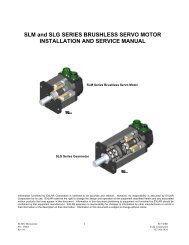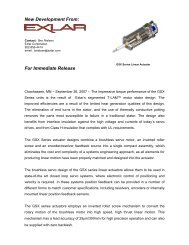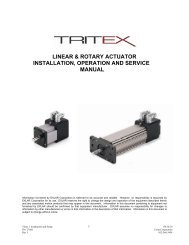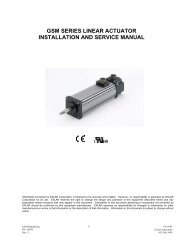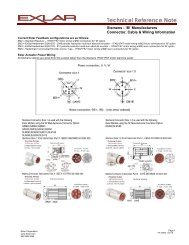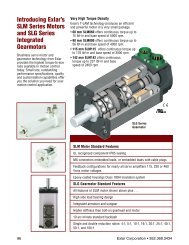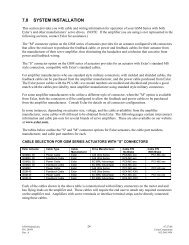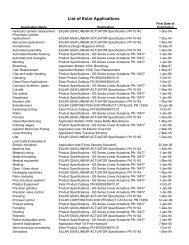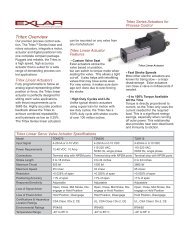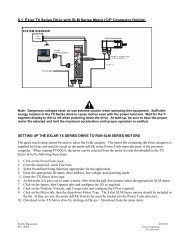Create successful ePaper yourself
Turn your PDF publications into a flip-book with our unique Google optimized e-Paper software.
Motor Torque<br />
Motor Torque Calculations<br />
When selecting an actuator system it is<br />
necessary to determine the required motor<br />
torque to perform the given application.<br />
These calculations can then be compared to<br />
the torque ratings of the given amplifier and<br />
motor combination that will be used to<br />
control the actuator’s velocity and position.<br />
When the system uses a separate motor and<br />
screw, like the FT actuator, the ratings for that<br />
motor and amplifier are consulted. In the<br />
case of the GSX Series actuators with their<br />
integral brushless motors, the required<br />
torque divided by the torque constant of the<br />
motor (Kt) must be less than the current<br />
rating of the GSX or SLM motor.<br />
Inertia values and torque ratings can be<br />
found in the GSX, FT, I and SLM/SLG Series<br />
product specifications.<br />
For the GSX Series the screw and motor<br />
inertia are combined.<br />
Motor with screw<br />
(GSX, GSM, FT, I & EL)<br />
Terms and (units)<br />
λ = Required motor torque, lbf-in (N-m)<br />
λa = Required motor acceleration torque, lbf-in (N-m)<br />
F = Applied force load, non inertial, lbf (N)<br />
S = Screw lead, in (mm)<br />
R = Belt or reducer ratio<br />
TL = Torque at driven load lbf-in (N-m)<br />
vL = Linear velocity of load in/sec (m/sec)<br />
ωL = Angular velocity of load rad/sec<br />
ωm = Angular velocity of motor rad/sec<br />
ŋ = Screw or ratio efficiency (≈ 85% for roller screws)<br />
g = Gravitational constant, 386.4 in/s 2 (9..75 m/s 2 )<br />
α = Angular acceleration of motor, rad/s 2<br />
m = Mass of the applied load, lb (N)<br />
JL = Reflected Inertia due to load, lbf-in-s 2 (N-m-s 2 )<br />
Jr = Reflected Inertia due to ratio, lbf-in-s 2 (N-m-s 2 )<br />
Js = Reflected Inertia due to external screw, lbf-in-s 2 (N-m-s 2 )<br />
Jm = Motor armature inertia, lbf-in-s 2 (N-m-s 2 )<br />
L = Length of screw, in (m)<br />
ρ = Density of screw material, lb/in 3 (kg/m 3 )<br />
r = Radius of screw, in (m)<br />
π = pi (3.14159.)<br />
C = Dynamic load rating, lbf (N)<br />
Velocity Equations<br />
Screw drive: V L = m*S/2π in/sec (m/sec)<br />
Motor & motor with reducer<br />
(SLM/SLG & ER)<br />
Motor with belt and pulley<br />
Belt or gear drive: ωm = ω L *R rad/sec<br />
Torque Equations<br />
Torque Under Load<br />
Screw drive (GS, FT or separate screw): λ = S • F lbf-in (N-m)<br />
2 • π • ŋ<br />
Belt and Pulley drive: λ = T L / R ŋ lbf-in (N-m)<br />
Gear or gear reducer drive: λ = T L / R ŋ lbf - in (N-m)<br />
Torque Under Acceleration<br />
λa = (J m + J R + (J s + J L )/R 2 )α lbf-in<br />
α = angular acceleration = ((RPM / 60) x 2π) / tacc, rad/sec 2 .<br />
Js = π • L • ρ x r 4 lb - in - s 2 (N - m - s 2 )<br />
2 • g<br />
Total Torque per move segment<br />
λT = λa + λ lbf-in (N-m)<br />
148 9.52.500.6200 | www.exlar.com



